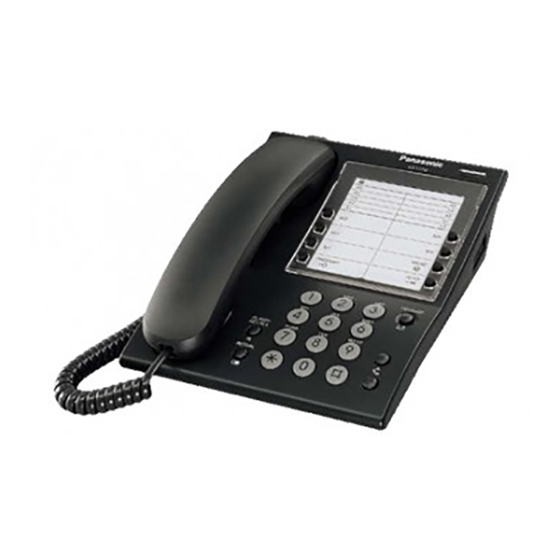
Panasonic KX-T7710 Quick Reference Manual
Panasonic business telephone system quick reference guide
Hide thumbs
Also See for KX-T7710:
- Quick reference manual (9 pages) ,
- Quick start manual (2 pages) ,
- Quick reference manual (6 pages)
Advertisement
Quick Links
Important Information
When using the KX-T7710, keep the following conditions in mind.
• If there is any problem, unplug the extension line and connect a known working phone.
If the known working phone operates properly, have the defective phone
If the
known working phone does not
operate properly, check the Panasonic KX series Business Telephone System and the
internal extension wiring.
• Keep the unit away from heating appliances and electrical noise generating devices
such as fluorescent lamps and motors.
• The unit should be kept free of dust, moisture and vibration, and should not be exposed
to direct sunlight.
• Do not
use thinner, or any
soft cloth.
• Do not disassemble this product. Dangerous electrical shock could result. The unit
must only be disassembled and repaired by qualified service technicians.
• Do not use any handset other than a Panasonic handset.
• The apparatus is designed to be installed and operated under controlled conditions of
ambient temperature and a relative humidity not greater
• Avoid installing the apparatus in damp or humid environments, such as in bathrooms or
near swimming pools.
• 999 and 112 can be dialled on the apparatus after
of making outgoing calls to the BT emergency (999) and (112) services.
WARNING:
TO PREVENT THE RISK OF FIRE OR ELECTRIC SHOCK, DO NOT EXPOSE THIS PRODUCT
TO RAIN OR ANY TYPE OF MOISTURE.
THIS HANDSET EARPIECE IS MAGNETISED AND MAY RETAIN SMALL FERROUS OBJECTS.
IMPORTANT NOTICE:
This product is designed for use in the U.K.
Note:
In this manual, the suffix of each model number is omitted.
2003 Panasonic Communications Co., Ltd. All Rights Reserved.
Quick Reference Guide
abrasive powder to clean the cabinet. Wipe it with a
Model No.
than 60%.
accessing the exchange line for the
KX-T7710
repaired.
purpose
Advertisement

Summary of Contents for Panasonic KX-T7710
-
Page 1: Quick Reference Guide
If the known working phone operates properly, have the defective phone If the known working phone does not operate properly, check the Panasonic KX series Business Telephone System and the internal extension wiring. • Keep the unit away from heating appliances and electrical noise generating devices such as fluorescent lamps and motors. -
Page 2: Features List
Off-hook On-hook * The Feature numbers described in this manual are KX-TDA100/KX-TDA200. If you are connected to a different Panasonic KX series Business Telephone System, please refer to its manuals. * "Location of Controls" is shown on page 5. Desired Function... - Page 3 Desired Function When the Dialled Extension is Busy/No Answer Sender Message Waiting Receiver Holding Holding a call Transferring a call To page Paging To answer a page During a conversation Three-party Conference desired phone no. To lock Locking your extension To unlock Features List Operation...
-
Page 4: Operations In Normal Mode
You can store up to 10 Station speed dial numbers. MESSAGE Button You can change the feature access number for the MESSAGE Button. [Default: 702] For more detail, refer to the manual for the connected Panasonic KX series Business Telephone Systems. Setting Lock/Unlock You can lock the settings for one-touch buttons and MESSAGE button. -
Page 5: Location Of Controls
Location of Controls The KX-T7710 has two modes, NORMAL Mode and Panasonic PBX Mode*. Please use the corresponding side of the Telephone Card depending on the mode. *The PBX Mode may not be available depending on the Telephone Systems to which you are connected. -
Page 6: Wall Mounting
Things You Should Know Wall Mounting Removing the Telephone Card Cover This product is intended to be connected to Panasonic KX series Business Telephone Systems only. We, Panasonic Communications Co., Ltd., declare that this equipment is in compliance with the essential requirements and other relevant provisions of Directive 1999/5/EC.









